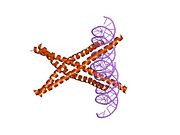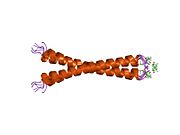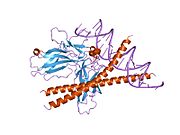Transcription factor Jun
Ensembl | |||||||||
|---|---|---|---|---|---|---|---|---|---|
| UniProt | |||||||||
| RefSeq (mRNA) | |||||||||
| RefSeq (protein) | |||||||||
| Location (UCSC) | Chr 1: 58.78 – 58.78 Mb | Chr 4: 94.94 – 94.94 Mb | |||||||
| PubMed search | [3] | [4] | |||||||
| View/Edit Human | View/Edit Mouse |
Transcription factor Jun is a
Function
Regulation
Both Jun and its dimerization partners in AP-1 formation are subject to regulation by diverse extracellular stimuli, which include peptide growth factors, pro-inflammatory
c-jun transcription is autoregulated by its own product, Jun. The binding of Jun (AP-1) to a high-affinity AP-1 binding site in the jun promoter region induces jun transcription. This positive autoregulation by stimulating its own transcription may be a mechanism for prolonging the signals from extracellular stimuli. This mechanism can have biological significance for the activity of c-jun in cancer.[9][10]
Also, the c-jun activities can be regulated by the ERK pathway. Constitutively active ERK is found to increase c-jun transcription and stability through CREB and GSK3. This results in activated c-jun and its downstream targets such as RACK1 and cyclin D1. RACK1 can enhance JNK activity, and activated JNK signaling subsequently exerts regulation on c-jun activity.[11]
It is activated through double phosphorylation by the
Phosphorylation of Jun at serines 63 and 73 and threonine 91 and 93 increases transcription of the c-jun target genes.[12] Therefore, regulation of c-jun activity can be achieved through N-terminal phosphorylation by the Jun N-terminal kinases (JNKs). It is shown that Jun's activity (AP-1 activity) in stress-induced apoptosis and cellular proliferation is regulated by its N-terminal phosphorylation.[13] Another study showed that oncogenic transformation by ras and fos also requires Jun N-terminal phosphorylation at Serine 63 and 73.[14]
Cell cycle progression
Studies have shown that c-jun is required for progression through the G1 phase of the cell cycle, and c-jun null cells show increased G1 arrest. C-jun regulates the transcriptional level of cyclin D1, which is a major Rb kinase. Rb is a growth suppressor, and it is inactivated by phosphorylation. Therefore, c-jun is required for maintaining sufficient cyclin D1 kinase activity and allowing cell cycle progression.[6]
In cells absent of c-jun, the expression of p53 (cell cycle arrest inducer) and p21 (CDK inhibitor and p53 target gene) is increased, and those cells exhibit cell cycle defects. Overexpression of c-jun in cells results in decreased level of p53 and p21, and exhibits accelerated cell proliferation. C-jun represses p53 transcription by binding to a variant AP-1 site in the p53 promoter. Those results indicate that c-jun downregulates p53 to control cell cycle progression.[15]
Anti-apoptotic activity
UV irradiation can activate c-jun expression and the JNK signaling pathway. C-jun protects cells from UV-induced
A study utilized liver-specific inactivation of c-jun in hepatocellular carcinoma, which showed impaired tumor development correlated with increased level of p53 protein and the mRNA level of the p53 target gene noxa. Also, c-jun can protect hepatocytes from apoptosis, as hepatocytes lacking c-jun showed increased sensitivity to TNFα-induced apoptosis. In those hepatocytes lacking c-jun, deletion of p53 can restore resistance toward TNFα. Those results indicate that c-jun antagonizes the proapoptotic activity of p53 in liver tumor.[16]
Clinical significance
It is known that c-jun plays a role in cellular proliferation and apoptosis of the endometrium throughout the menstrual cycle. The cyclic change of the c-jun protein levels is significant in the proliferation and apoptosis of glandular epithelial cells. The persistent stromal expression of c-jun protein may prevent stromal cells from entering into apoptosis during the late secretory phase.[17]
Cancer
In a study using
A study with a group consisted of 103 cases of phase I/II invasive breast cancers showed that activated c-jun is expressed predominantly at the invasive front of breast cancer and is associated with proliferation and angiogenesis.[19]
Tumor initiation
A study was done with liver-specific inactivation of c-jun at different stages of tumor development in mice with chemically induced hepatocellular carcinomas. The result indicates that c-jun is required at the early stage of tumor development, and deletion of c-jun can largely suppress tumor formation. Also, c-jun is required for tumor cell survival between the initiation and progression stages. In contrast to that, inactivation of c-jun in advanced tumors does not impair tumor progression.[16]
Breast cancer
Overexpression of c-jun in MCF-7 cells can result in overall increased aggressiveness, as shown by increased cellular motility, increased expression of a matrix-degrading enzyme
The invasive phenotype contributed by c-jun overexpression is confirmed in another study. In addition, this study showed increased in vivo liver metastasis by the breast cancer with c-jun overexpression. This finding suggests that c-jun plays a critical role in the metastasis of breast cancer.[21]
In mammary tumors, endogenous c-jun was found to play a key role in
Vulvar cancer
C-jun has been observed overexpressed in Vulvar Squamous Cell Carcinoma samples, in association with hypermethylation-Induced inactivation of the RARB tumor suppressor gene.[9] Indeed, mRNA levels of c-Jun tested higher in Vulvar cancer samples when compared with those of normal skin and preneoplastic vulvar lesions, thus underscoring a cross-link between RARB gene and the oncogene c-Jun.[9]
Cellular differentiation
Ten undifferentiated and highly aggressive sarcomas showed amplification of the jun gene and JUN overexpression at both RNA and protein levels. Overexpression of c-jun in 3T3-L1 cells (a preadipocytic non-tumoral cell line that resembles human liposarcoma) can block or delay adipocytic differentiation of those cells.[23]
Nerve and spinal cord regeneration
Peripheral nerve injury in rodents rapidly activates JNK signaling which in turn activates c-Jun. In contrast, nerve injury in the central nervous system does not. c-Jun is sufficient to promote axon regeneration in both the peripheral and central nervous systems as overexpression in both dorsal root ganglion neurons and cortical neurons leads to increased regeneration.[24]
As anti-cancer drug target
Since c-jun has been observed overexpressed in cancer,[9] several studies highlighted the hypothesis that this gene might be a target for cancer therapy. A study showed that oncogenic transformation by ras and fos requires Jun N-terminal phosphorylation at Serine 63 and 73 by the Jun N- terminal kinases (JNK). In this study, the induced skin tumor and osteosarcoma showed impaired development in mice with a mutant Jun incapable of N-terminal phosphorylation.[14] Also, in a mouse model of intestinal cancer, genetic abrogation of Jun N-terminal phosphorylation or gut-specific c-jun inactivation attenuated cancer development and prolonged lifespan.[12] Therefore, targeting the N-terminal phosphorylation of Jun (or the JNK signaling pathway) can be a potential strategy for inhibiting tumor growth.
In melanoma-derived B16-F10 cancer cells, c-jun inactivation by a pharmacological JNK/jun inhibitor SP combined with JunB knockdown can result in cytotoxic effect, leading to cell arrest and apoptosis. This anti-JunB /Jun strategy can increase the survival of mice inoculated with tumor cells, which suggests a potential antitumor strategy through Jun and JunB inhibition.[25]
Anti-cancer property of c-jun
Most research results show that c-jun contributes to tumor initiation and increased invasiveness. However, a few studies discovered some alternative activities of c-jun, suggesting that c-jun may actually be a double-edge sword in cancer.[26]
p16
p16INK4a is a tumor suppressor and a cell cycle inhibitor, and a study shows that c-jun acts as “bodyguard” to p16INK4a by preventing methylation of the p16INK4a promoter. Therefore, c-jun can prevent silencing of the gene p16INK4a.[citation needed]
Tylophorine
Tylophorine is a type of plant-derived alkaloid with anticancer activity by inducing cell cycle arrest. A study demonstrated that tylophorine treatment increased c-jun protein accumulation. Then c-jun expression in conjunction with tylophorine promotes G1 arrest in carcinoma cells through the downregulation of cyclin A2. Therefore, the result indicates that the anticancer mechanism of tylophorine is mediated through c-jun.[27]
Interactions
C-jun has been shown to
- ATF2[28][29][30]
- AR[31]
- ASCC3[32]
- ATF3[30][33][34]
- BCL3[35]
- BCL6[36]
- BRCA1[37]
- CSNK2A1[45]
- COPS5[46]
- CREBBP[47]
- CSNK2A2[45]
- DDX21,[48]
- DDIT3[49]
- ERG[50]
- ETS2,[51]
- FOSL1[39]
- GTF2B[52]
- MAPK8[53][54][55][56][57][58][59][60]
- MyoD[61]
- NACA[62]
- NELFB[63]
- NFE2L1[44]
- NFE2L2[44]
- NCOR2[64]
- NCOA1[65][66][67]
- PIN1[68]
- RBM39[69]
- RELA[41]
- RB1[70]
- RFWD2[71][72]
- RUNX1[73][74]
- RUNX2[73][74]
- SMAD3[75][76][77]
- STAT1[78]
- STAT3[78]
- TBP[52]
- TGIF1[79]
See also
References
- ^ a b c GRCh38: Ensembl release 89: ENSG00000177606 - Ensembl, May 2017
- ^ a b c GRCm38: Ensembl release 89: ENSMUSG00000052684 - Ensembl, May 2017
- ^ "Human PubMed Reference:". National Center for Biotechnology Information, U.S. National Library of Medicine.
- ^ "Mouse PubMed Reference:". National Center for Biotechnology Information, U.S. National Library of Medicine.
- S2CID 44145552.
- ^ PMID 9878062.
- PMID 3033666.
- ^ "Entrez Gene: JUN jun oncogene".
- ^ PMID 29898214.
- S2CID 19043736.
- PMID 17482134.
- ^ S2CID 4373376.
- S2CID 25622141.
- ^ PMID 10851065.
- PMID 10072388.
- ^ S2CID 8358992.
- S2CID 29512406.
- PMID 8542585.
- PMID 16733206.
- PMID 10557095.
- PMID 17672916.
- PMID 20053993.
- PMID 17418412.
- PMID 29666508.
- PMID 17667939.
- S2CID 35328722.
- PMID 23385061.
- S2CID 85570533.
- PMID 2320002.
- ^ PMID 1827203.
- PMID 9211894.
- PMID 12077347.
- PMID 14667575.
- PMID 8622660.
- PMID 10497212.
- PMID 12165517.
- PMID 12080089.
- PMID 11053448.
- ^ PMID 9160889.
- S2CID 4276971.
- ^ PMID 10488148.
- PMID 8440710.
- PMID 8380166.
- ^ PMID 9872330.
- ^ PMID 9685505.
- S2CID 4353893.
- PMID 9786917.
- PMID 11823437.
- PMID 10523647.
- S2CID 32288807.
- PMID 9334186.
- ^ PMID 7848298.
- PMID 14633987.
- PMID 9774977.
- S2CID 6797795.
- PMID 12052834.
- PMID 11479302.
- PMID 8621542.
- PMID 8586671.
- PMID 9207092.
- S2CID 44966899.
- PMID 9488446.
- PMID 15530430.
- PMID 10777532.
- PMID 10567404.
- PMID 10847592.
- PMID 9642216.
- PMID 11432833.
- PMID 11704680.
- PMID 10026157.
- S2CID 40501515.
- PMID 12615916.
- ^ PMID 11274169.
- ^ PMID 11641401.
- S2CID 4393852.
- PMID 10903323.
- PMID 10220381.
- ^ PMID 10490649.
- PMID 11371641.
Further reading
- Bohmann D, Bos TJ, Admon A, Nishimura T, Vogt PK, Tjian R (December 1987). "Human proto-oncogene c-jun encodes a DNA binding protein with structural and functional properties of transcription factor AP-1". Science. 238 (4832): 1386–92. PMID 2825349.
- Rahmsdorf HJ (December 1996). "Jun: transcription factor and oncoprotein". Journal of Molecular Medicine. 74 (12): 725–47. S2CID 2693522.
- Liu JL, Kung HJ (2001). "Marek's disease herpesvirus transforming protein MEQ: a c-Jun analogue with an alternative life style". Virus Genes. 21 (1–2): 51–64. S2CID 2303249.
- Velazquez Torres A, Gariglio Vidal P (2002). "[Possible role of transcription factor AP1 in the tissue-specific regulation of human papillomavirus]". Revista de Investigacion Clinica. 54 (3): 231–42. PMID 12183893.
- Karamouzis MV, Konstantinopoulos PA, Papavassiliou AG (February 2007). "The activator protein-1 transcription factor in respiratory epithelium carcinogenesis". Molecular Cancer Research. 5 (2): 109–20. PMID 17314269.
External links
- c-jun+Proteins at the U.S. National Library of Medicine Medical Subject Headings (MeSH)
- c-jun+Genes at the U.S. National Library of Medicine Medical Subject Headings (MeSH)
- Drosophila Jun-related antigen - The Interactive Fly
- FactorBook C-Jun
- Human JUN genome location and JUN gene details page in the UCSC Genome Browser.






